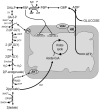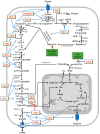The Warburg Effect 97 Years after Its Discovery
- PMID: 33008042
- PMCID: PMC7599761
- DOI: 10.3390/cancers12102819
The Warburg Effect 97 Years after Its Discovery
Abstract
The deregulation of the oxidative metabolism in cancer, as shown by the increased aerobic glycolysis and impaired oxidative phosphorylation (Warburg effect), is coordinated by genetic changes leading to the activation of oncogenes and the loss of oncosuppressor genes. The understanding of the metabolic deregulation of cancer cells is necessary to prevent and cure cancer. In this review, we illustrate and comment the principal metabolic and molecular variations of cancer cells, involved in their anomalous behavior, that include modifications of oxidative metabolism, the activation of oncogenes that promote glycolysis and a decrease of oxygen consumption in cancer cells, the genetic susceptibility to cancer, the molecular correlations involved in the metabolic deregulation in cancer, the defective cancer mitochondria, the relationships between the Warburg effect and tumor therapy, and recent studies that reevaluate the Warburg effect. Taken together, these observations indicate that the Warburg effect is an epiphenomenon of the transformation process essential for the development of malignancy.
Keywords: Warburg effect; glycolysis; oncogenes; oxidative metabolism; tumor therapy.
Conflict of interest statement
The authors declare no conflict of interest.
Figures









References
-
- Warburg O. Versuche an überlebendem carcinom-gewebe. Klin. Wochenschr. 1923;2:776–777. doi: 10.1007/BF01712130. - DOI
-
- Warburg O. Über den stoffwechsel der carcinomzelle. Naturwissenschaften. 1924;12:1131–1137. doi: 10.1007/BF01504608. - DOI
-
- Elwood J., Lin Y., Cristofalo V., Weinhouse S., Morris H.P. Glucose utilization in homogenates of the Morris hepatoma 5123 and related tumors. Cancer Res. 1963;23:906–913. - PubMed
-
- Weinhouse S. Glycolysis, respiration, and anomalous gene expression in experimental hepatomas. G.H.A. Clowes memorial lecture. Cancer Res. 1972;32:2007–2016. - PubMed
Publication types
Grants and funding
LinkOut - more resources
Full Text Sources

